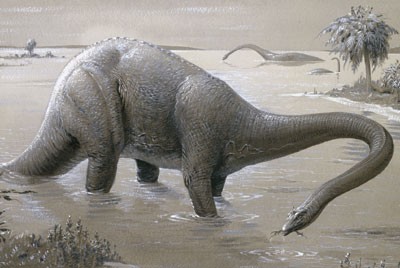
- Select a language for the TTS:
- UK English Female
- UK English Male
- US English Female
- US English Male
- Australian Female
- Australian Male
- Language selected: (auto detect) - EN
Play all audios:
Credit: N. PARKER/NATURAL HISTORY MUSEUM, LONDON _J. Evol. Biol._ 22, 446–459 (2009) Many palaeontologists have long thought that flowering plants and dinosaurs co-evolved because many
species of both appeared during the Cretaceous period, 145 million to 65 million years ago. This now seems unlikely. Richard Butler and his colleagues at London's Natural History Museum
have mapped the species diversity of fossil finds encompassing 407 species of dinosaur (including those of diplodocus, pictured below) and more than 2,300 species of plant. They found no
overall geographical correlation between the two data sets. Instead, they learned that stegosaur diversity was negatively correlated with the diversity of flowering plants and positively
correlated with that of non-flowering cycadophytes, which hints that the spiny-backed group ate cycadophytes. RIGHTS AND PERMISSIONS Reprints and permissions ABOUT THIS ARTICLE CITE THIS
ARTICLE Palaeontology: Flower power. _Nature_ 457, 1061 (2009). https://doi.org/10.1038/4571061c Download citation * Published: 25 February 2009 * Issue Date: 26 February 2009 * DOI:
https://doi.org/10.1038/4571061c SHARE THIS ARTICLE Anyone you share the following link with will be able to read this content: Get shareable link Sorry, a shareable link is not currently
available for this article. Copy to clipboard Provided by the Springer Nature SharedIt content-sharing initiative

:max_bytes(150000):strip_icc():focal(319x0:321x2)/people_social_image-60e0c8af9eb14624a5b55f2c29dbe25b.png)







